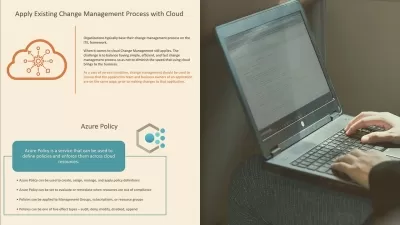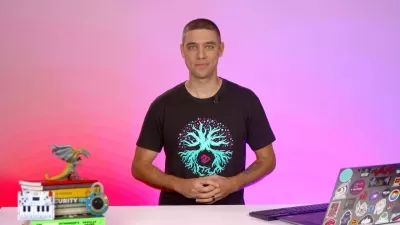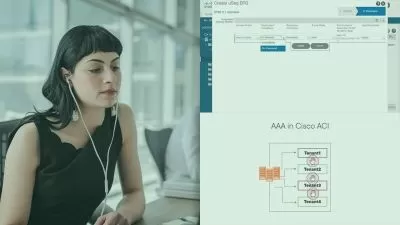CompTIA SY0-701: Threats,Vulnerabilities & Mitigations-Vol 2
Anand Rao Nednur
9:37:16
Description
Tackling Threats, Vulnerabilities, and Their Mitigations
What You'll Learn?
- Identify and differentiate between various threat actors including nation-states, insiders, hacktivists, and organized criminals.
- Analyze the motivations behind cyber attacks ranging from financial gain to espionage and political beliefs.
- Explore how attackers exploit different communication mediums like email, SMS, and instant messaging.
- Understand the vulnerabilities associated with various technologies including removable devices, unsecured networks, and open service ports.
- Dive deep into application, operating system, web, hardware, and cloud-specific vulnerabilities.
- Learn about zero-day vulnerabilities, misconfigurations, and the risks involved with legacy and end-of-life systems.
- Develop skills to detect and analyze signs of cyber attacks and breaches, preparing for effective incident response.
- Master a range of mitigation techniques and best practices to defend against malware, network attacks, application attacks, and more.
- Understand the importance of encryption, access control, patching, and other hardening techniques to protect organizational assets.
Who is this for?
What You Need to Know?
More details
DescriptionCybersecurity threats are becoming more sophisticated, and the need for skilled professionals has never been higher. Whether you're an aspiring cybersecurity specialist, an IT professional seeking to specialize in security, or a business owner looking to safeguard your digital assets, this course provides the comprehensive insights and practical skills you need to succeed. By the end of this module, you'll not only be prepared to take the CompTIA Security+ SY0-701 exam but also to implement robust security measures in various professional contexts.
What You Will Learn
Understanding Cybersecurity Threat Actors and Motivations: Delve into the psyche and methodologies of various threat actors, including nation-states, insider threats, and hacktivists. Learn to predict potential attacks by understanding their motivations, from financial gain to espionage.
Comprehensive Overview of Threat Vectors and Attack Surfaces: Explore the myriad ways cyber attacks can infiltrate systems, from phishing emails and malware-laden attachments to insecure networks and vulnerable software. Understand how to identify and secure potential weaknesses in your organization's digital armor.
In-Depth Analysis of Cybersecurity Vulnerabilities: Gain expert knowledge on the types of vulnerabilities that can exist across applications, operating systems, hardware, and cloud-based systems. Learn about zero-day vulnerabilities, misconfigurations, and the risks associated with legacy systems.
Identifying and Analyzing Indicators of Compromise: Master the art of detecting early signs of cyber breaches. Develop skills in analyzing logs, recognizing unusual system behavior, and effectively responding to mitigate damage.
Mitigation Techniques to Secure Enterprises: Learn about the latest strategies and tools to defend against and respond to cyber attacks. From implementing robust malware defenses to crafting effective access control and encryption policies, equip yourself with the knowledge to build a comprehensive security framework.
Who this course is for:
- Students preparing for the CompTIA Security+ SY0-701 certification exam.
- IT professionals seeking specialized knowledge in cybersecurity threats, vulnerabilities, and mitigations.
- Individuals looking to start or advance their career in cybersecurity.
- Individuals looking to start a career in cybersecurity will find this course provides a solid foundation in understanding threats, vulnerabilities, and how to mitigate them.
- IT practitioners aiming to transition into cybersecurity roles or enhance their security skills will benefit from the detailed exploration of threat actors, attack vectors, and security measures.
- College or university students and recent graduates in computer science, information technology, or related fields seeking to bolster their resumes with cybersecurity credentials.
- Anyone interested in understanding the landscape of cyber threats and how to protect personal or organizational assets against cyber attacks.
- Individuals responsible for managing IT resources or overseeing cybersecurity measures in small businesses will gain practical knowledge and strategies for safeguarding their operations.
Cybersecurity threats are becoming more sophisticated, and the need for skilled professionals has never been higher. Whether you're an aspiring cybersecurity specialist, an IT professional seeking to specialize in security, or a business owner looking to safeguard your digital assets, this course provides the comprehensive insights and practical skills you need to succeed. By the end of this module, you'll not only be prepared to take the CompTIA Security+ SY0-701 exam but also to implement robust security measures in various professional contexts.
What You Will Learn
Understanding Cybersecurity Threat Actors and Motivations: Delve into the psyche and methodologies of various threat actors, including nation-states, insider threats, and hacktivists. Learn to predict potential attacks by understanding their motivations, from financial gain to espionage.
Comprehensive Overview of Threat Vectors and Attack Surfaces: Explore the myriad ways cyber attacks can infiltrate systems, from phishing emails and malware-laden attachments to insecure networks and vulnerable software. Understand how to identify and secure potential weaknesses in your organization's digital armor.
In-Depth Analysis of Cybersecurity Vulnerabilities: Gain expert knowledge on the types of vulnerabilities that can exist across applications, operating systems, hardware, and cloud-based systems. Learn about zero-day vulnerabilities, misconfigurations, and the risks associated with legacy systems.
Identifying and Analyzing Indicators of Compromise: Master the art of detecting early signs of cyber breaches. Develop skills in analyzing logs, recognizing unusual system behavior, and effectively responding to mitigate damage.
Mitigation Techniques to Secure Enterprises: Learn about the latest strategies and tools to defend against and respond to cyber attacks. From implementing robust malware defenses to crafting effective access control and encryption policies, equip yourself with the knowledge to build a comprehensive security framework.
Who this course is for:
- Students preparing for the CompTIA Security+ SY0-701 certification exam.
- IT professionals seeking specialized knowledge in cybersecurity threats, vulnerabilities, and mitigations.
- Individuals looking to start or advance their career in cybersecurity.
- Individuals looking to start a career in cybersecurity will find this course provides a solid foundation in understanding threats, vulnerabilities, and how to mitigate them.
- IT practitioners aiming to transition into cybersecurity roles or enhance their security skills will benefit from the detailed exploration of threat actors, attack vectors, and security measures.
- College or university students and recent graduates in computer science, information technology, or related fields seeking to bolster their resumes with cybersecurity credentials.
- Anyone interested in understanding the landscape of cyber threats and how to protect personal or organizational assets against cyber attacks.
- Individuals responsible for managing IT resources or overseeing cybersecurity measures in small businesses will gain practical knowledge and strategies for safeguarding their operations.
User Reviews
Rating
Anand Rao Nednur
Instructor's Courses
Udemy
View courses Udemy- language english
- Training sessions 159
- duration 9:37:16
- Release Date 2024/05/04






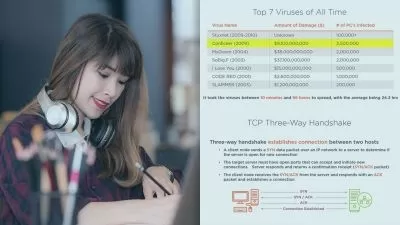

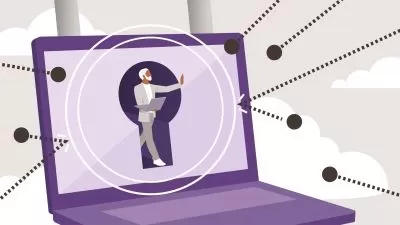


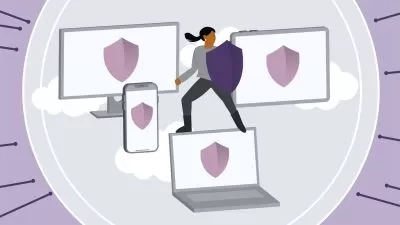

![[NEW] Spring Security 6 Zero to Master along with JWT,OAUTH2](https://traininghub.ir/image/course_pic/17240-x225.webp)

